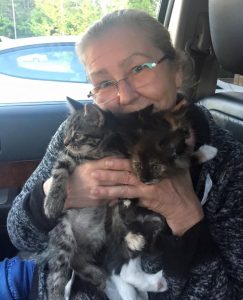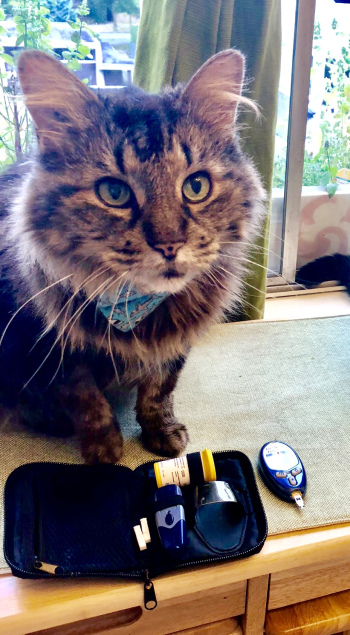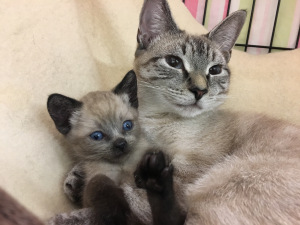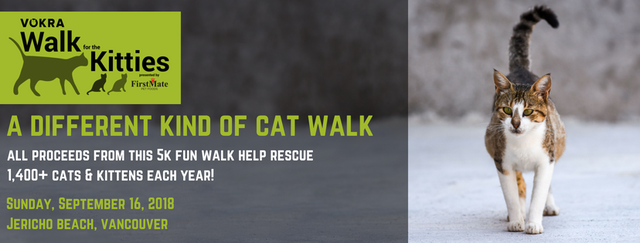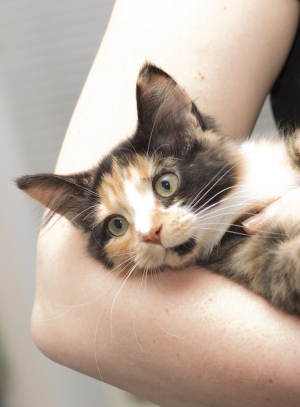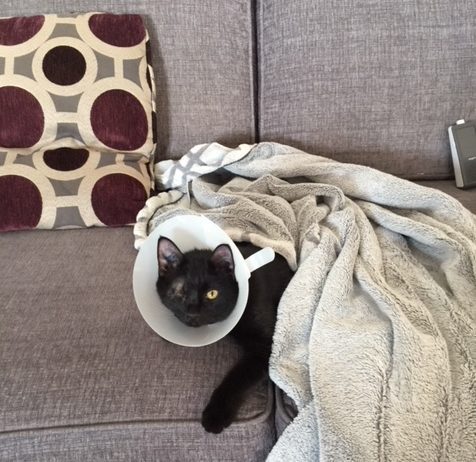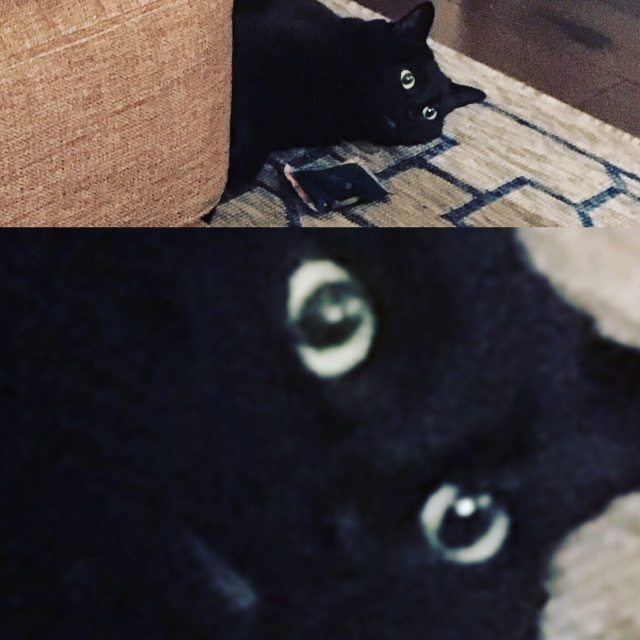 Would-be cat parents Ella and Mario de Torres were scanning the VOKRA blog when they came across an Adopt Me article featuring two cute kitties in search of a forever home. After a quick read, Ella and Mario realized they’d found their cats! Soon Trixie (now Sushi) and her son Mike (now Kimchi) were on their way to a new place.
Would-be cat parents Ella and Mario de Torres were scanning the VOKRA blog when they came across an Adopt Me article featuring two cute kitties in search of a forever home. After a quick read, Ella and Mario realized they’d found their cats! Soon Trixie (now Sushi) and her son Mike (now Kimchi) were on their way to a new place.
There was no doubt in Ella and Mario’s minds they’d made the right choice. In their foster home the two cats were coming out of their respective shells, with the small mom meowing chattily and her son showing a marked fondness for pats and playtime with strings and sticks.
 But now after eight months with Ella and Mario, Sushi and Kimchi are showing their true and adorable colours. Ella has many “meow-versations” with chatty Sushi. “She sounds like a trilling pigeon!” said Ella.
But now after eight months with Ella and Mario, Sushi and Kimchi are showing their true and adorable colours. Ella has many “meow-versations” with chatty Sushi. “She sounds like a trilling pigeon!” said Ella.
At first, though, Sushi needed a bit of time to get used to her new home. Ella describes the first few months as being “like a cha-cha – we’d feel like we were making progress, but then something would spook her and she’d be back to hiding again.” One such spook happened early on when Sushi’s small paw stepped on a remote control that operated Ella and Mario’s bedroom ceiling fan. “Sushi was so frightened she wouldn’t walk past the open bedroom door!” said Ella. Fortunately, Sushi’s now settled in and has become much more confident and cuddly. In Ella’s words, “She’s a serious lap cat. There are times when I have literally just made contact with the couch and her paw is already on my thigh, demanding a lap to sit on!”
 Kimchi too has gotten braver and braver the more time he spends living with Ella and Mario. In fact, the (human!) couple have nicknamed their boy “Explorer Cat” and he continues to lives up to that name, always climbing up to a high vantage point to survey his domain. When Kimchi’s down on the ground, he’ll spend time “zooming,” as Ella put it, running around like a “crazy cat”. In true cat fashion, the zoomies often come in the early morning when Ella and her husband are happily snoozing! As you might expect from all that activity, Kimchi likes his food. In the mornings he’ll “meeeeeoooooow pitifully as if he’s starving and will continue to meow until someone opens the bedroom door,” said Ella.
Kimchi too has gotten braver and braver the more time he spends living with Ella and Mario. In fact, the (human!) couple have nicknamed their boy “Explorer Cat” and he continues to lives up to that name, always climbing up to a high vantage point to survey his domain. When Kimchi’s down on the ground, he’ll spend time “zooming,” as Ella put it, running around like a “crazy cat”. In true cat fashion, the zoomies often come in the early morning when Ella and her husband are happily snoozing! As you might expect from all that activity, Kimchi likes his food. In the mornings he’ll “meeeeeoooooow pitifully as if he’s starving and will continue to meow until someone opens the bedroom door,” said Ella.
All in all, Ella and Mario are delighted with their new snuggle bugs. And we couldn’t be happier to report yet another happy tail!
Would you like to share your Happy Tail? Email us at [email protected].
]]>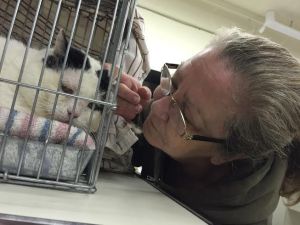 It’s hard to keep track of all the acronyms that exist these days, but in the cat rescue world TNR is a big one. TNR stands for Trap-Neuter-Return and describes the process of trapping feral cats, spaying or neutering them, and then returning them to the location they came from. According to VOKRA co-founder Maria Soroski, it’s the most effective and humane way to help control the feral cat population.
It’s hard to keep track of all the acronyms that exist these days, but in the cat rescue world TNR is a big one. TNR stands for Trap-Neuter-Return and describes the process of trapping feral cats, spaying or neutering them, and then returning them to the location they came from. According to VOKRA co-founder Maria Soroski, it’s the most effective and humane way to help control the feral cat population.
When VOKRA formed back in 2000, Maria had no idea what a feral cat was, which is hard to believe for someone who is such a strong advocate for Vancouver street cats. She, along with fellow co-founder Karen Duncan, began by bottle feeding kittens that had been brought into the SPCA before branching off on their own to create VOKRA.
“I had no idea where the kittens were coming from,” says Maria, who wondered what happened to the kittens’ moms. “I assumed they were from owned cats or that they’d been orphaned.” However, as kittens kept arriving from the same addresses, Maria and Karen started to do a little sleuthing. They soon discovered a whole world of feral cats. The mother cats hadn’t been brought in because they were wild – no one could touch them, let alone pick them up and transport them into care.
Maria discovered entire colonies, some with upwards of 50 cats. They were all the moms, dads, aunts, uncles and cousins of all the bottle-fed kittens that had come in. Thanks to the guidance of local rescuers and the resources of Alley Cat Allies, Maria quickly learned to trap and hasn’t looked back since.
VOKRA’s volunteer trappers, spearheaded by Maria, spent eight years trapping seven days a week in Vancouver and Burnaby. It’s estimated there were more than 8000 – 9000 free roaming cats in Vancouver before VOKRA came along. The number of feral cats is now down to less than 300 with the remaining colonies under control. Some of the colonies now consist solely of senior citizen cats, who pass on humanely after living a life on their own terms.
For cats that we can’t return to their original site, we try and find them another home – specifically a barn or hobby farm. Janet, who coordinates the barn cat placement program, says “It’s an alternative option for feral cats that are unable to be returned to their original location for various reasons.” The barns are located throughout the Lower Mainland, from Abbotsford to Squamish, and Janet often drives the cats to their new homes herself. Potential placements are interviewed in advance and the cats are guaranteed fresh food and water daily, along with a safe shelter area. In their new “jobs” as rodent control technicians they have a better life than they would out on the streets.
If the cats are young enough or semi-tame, then we’ll try to socialize them so we can adopt them to forever homes. “We’re not scared of hissy babies,” says Maria. Armed with gloves, towels, treats, and a whole lot of patient love, VOKRA volunteers socialize kittens in their homes. VOKRA runs workshops and provides coaching to these special families. Fosters tell us this is an immensely rewarding part of being with VOKRA. To watch a kitten or adult cat transform from an untrusting and extremely frightened creature to one that seeks out your affection with headbutts to your hand, and who purrs at the very sound of your voice, is a truly amazing experience.
 We respond to as many calls we can and trap feral cats, tame moms protecting their kittens and tame adults that are too afraid to trust humans just yet. Sometimes this involves all-night efforts and sometimes it involves walking into an abandoned house in protective gear so as not to be eaten alive by the swarms of fleas. Whatever it takes – the fate of all cats is important to us and those who were never given the chance to live a safe, indoor life deserve the best that we can give them.
We respond to as many calls we can and trap feral cats, tame moms protecting their kittens and tame adults that are too afraid to trust humans just yet. Sometimes this involves all-night efforts and sometimes it involves walking into an abandoned house in protective gear so as not to be eaten alive by the swarms of fleas. Whatever it takes – the fate of all cats is important to us and those who were never given the chance to live a safe, indoor life deserve the best that we can give them.
As a non-profit association we rely on the contributions of people like you. If you’d like to support our TNR program click here.
]]>
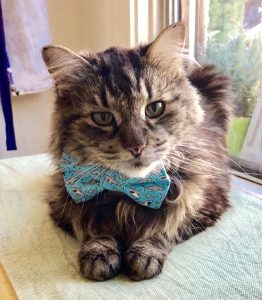 Rachel and her partner Chris already had three cats and were not looking to adopt another when they sat down to read the VOKRA newsletter together earlier this year. Living with Type 1 diabetes herself, the article on Timmy, an older male Maine Coon with diabetes, really resonated with Rachel. In fact, one of her previous cats also had diabetes so she was familiar with how to care for a diabetic cat. However, they were already short on space and were confident Timmy would find a forever home soon.
Rachel and her partner Chris already had three cats and were not looking to adopt another when they sat down to read the VOKRA newsletter together earlier this year. Living with Type 1 diabetes herself, the article on Timmy, an older male Maine Coon with diabetes, really resonated with Rachel. In fact, one of her previous cats also had diabetes so she was familiar with how to care for a diabetic cat. However, they were already short on space and were confident Timmy would find a forever home soon.
Several months later another VOKRA email arrived in Rachel’s inbox featuring Timmy front and centre. Once again Timmy’s story was used to highlight how your donations to VOKRA are used to care for special kitties in need. Rachel’s heart went out to Timmy and, after convincing Chris, she contacted VOKRA to arrange a meeting.
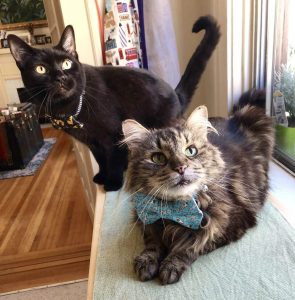 Visiting Timmy at his foster home (only five blocks from her own!), Rachel was able to review his lengthy medical files. It turns out Timmy had been a struggling diabetic without a permanent home for nearly seven years. Furthering her bond with him, Rachel learned Timmy was on the same insulin and required the same glucose checks as she did. Despite her concerns that adopting Timmy into their happy three cat home could potentially disrupt the other cats’ lives, Rachel knew the value of giving Timmy the opportunity for a happy, stable home overshadowed the risks. Rachel and Chris decided to take the plunge and take Timmy home.
Visiting Timmy at his foster home (only five blocks from her own!), Rachel was able to review his lengthy medical files. It turns out Timmy had been a struggling diabetic without a permanent home for nearly seven years. Furthering her bond with him, Rachel learned Timmy was on the same insulin and required the same glucose checks as she did. Despite her concerns that adopting Timmy into their happy three cat home could potentially disrupt the other cats’ lives, Rachel knew the value of giving Timmy the opportunity for a happy, stable home overshadowed the risks. Rachel and Chris decided to take the plunge and take Timmy home.
The first thing Rachel and Chris did when they adopted Timmy was to change his name to Louie. Shortly prior to his adoption, it was discovered that Louie needed emergency surgery to remove his teeth. The recovery was difficult for an older diabetic cat like Louie and developed pancreatitis. After a few close calls and attentive care from Rachel and Chris, Louie pulled through.
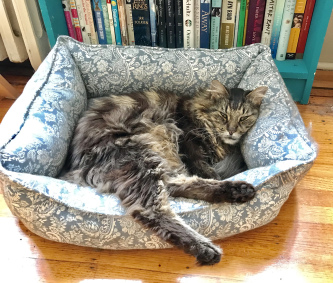 It took a month for all three cats to come around but Louie has now been accepted as part of the clowder. Louie’s a lover of all people food but is kept on a strict diet and schedule to manage his diabetes (even though Chris sneaks him a tiny taste here and there!). In fact, Louie’s diabetes has improved since his adoption and he now requires less daily units of insulin to manage his glucose levels.
It took a month for all three cats to come around but Louie has now been accepted as part of the clowder. Louie’s a lover of all people food but is kept on a strict diet and schedule to manage his diabetes (even though Chris sneaks him a tiny taste here and there!). In fact, Louie’s diabetes has improved since his adoption and he now requires less daily units of insulin to manage his glucose levels.
Since Rachel treats her own diabetes she quickly accepted Louie’s needs as part of her routine. “I think, if anything, taking care of him has left me feeling like I’m not alone,” said Rachel. “It never felt to me like I was taking on too much more, but rather I was gaining someone who was helping me deal with my depression around diabetes. A support buddy!”
Thank you so much to Rachel and Chris for giving Louie the loving home he’s been waiting for. We wish you all many happy years together!
Would you like to share your Happy Tail? Email us at [email protected].
]]>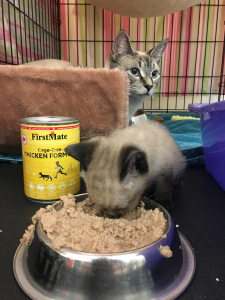
Little Nugget enjoying a snack
At VOKRA, we do our best to ensure all kitties who pass through our doors live the best lives they can. That’s why when we come across issues we always look for a pattern and try to find a solution.
Unfortunately, from time-to-time cats are returned to us due to behavioural issues, and the most common of these issues is peeing outside of the litter box. More times than not, the root cause is diet and stems from the fact the cat is fed primarily dry food.
Cats who eat mostly dry food also tend to have more urinary tract infections. And cats that are free fed, which is when food is left out for the cat to self-monitor their own diet, have it even worse as they’re often fat so they can’t clean themselves properly.
So, why is dry food the culprit?
Cats are designed by nature to be carnivores and their digestive tract, despite thousands of years of domestication, is not intended to assimilate dry food. Not only so, contrary to popular belief, dry food causes plaque to form on teeth. It’s also highly processed, making the body work anywhere from 12-18 hours to break it down. This means the cat is always half full and in a constant state of digestion. On the other hand, raw food moves through the body within four hours, while wet food takes 8-12 hours for the body to metabolize it.
Karen Duncan, co-founder of VOKRA, has fed a raw diet to all of her animals for more than 20 years and fully recommends a wet or raw diet for all kitties. At VOKRA, FirstMate is our first choice for the cats in our care and Karen explains why:
“We got involved with FirstMate a few years ago. They’re a local company, which beats buying masses of food shipped from the US. Every product is cruelty free as the protein is sourced ethically – all wild salmon and tuna, never farmed. There’s never any guar gum or thickeners. Instead, potatoes or peas are used. Their packaging is also epoxy free and the label is foil laminate, making everything recyclable. VOKRA’s very confident of the quality of FirstMate food and are able to get answers quickly from them if any arise.”
All of these reasons are why we feel so strongly about feeding cats a diet that primarily consists of wet or raw food.
So if your kitty is peeing outside of the box, has frequent urinary infections or stinky breath it will most likely be worthwhile for you to switch their diet away from dry. It will help save their health and will cost you less trips to the vet.
If you’d like to learn more about why wet is best click here.
]]>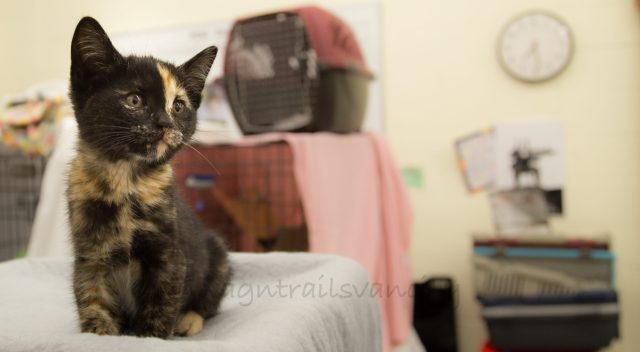 Kittens, kittens and more kittens.
Kittens, kittens and more kittens.
 Kitten season may be the cutest time of the year, but it means a lot of extra costs and work for us here at VOKRA. Each year during kitten season we care for more than 600 kittens, and this year’s no exception.
Kitten season may be the cutest time of the year, but it means a lot of extra costs and work for us here at VOKRA. Each year during kitten season we care for more than 600 kittens, and this year’s no exception.
As a volunteer-driven non-profit, we count on your support to be able to rescue so many kittens.
Kittens in our care have a chance at a happy, safe and healthy life. Kittens like these cuties who were found living at an industrial site out in Abbotsford. These little guys were lucky enough to be trapped by our dedicated volunteers and will now spend the rest of their lives in loving homes.
And, by taking these kittens off the streets and ensuring they’re spayed and neutered, we’re also breaking the cycle preventing more unwanted kittens from being born. It doesn’t take very long for five kittens to become 35, and for 35 kittens to become 105 and so on.
Kittens like these are just five of the thousands of reasons why we Walk for the Kitties.
Each year, VOKRA rescues more than 1,400 homeless cats and kittens from around the Lower Mainland. Our work is made possible through the generous support of volunteers, adopters and people like you.
Walk for the Kitties is our largest fundraising event of the year. This 5k fun walk takes place at Jericho Beach on September 16 and all funds raised go directly towards supporting our rescue efforts. Learn more here.
Without your support we wouldn’t be able to afford to rescue all these cats and kittens.
Please help this September 16 by joining us for Walk for the Kitties, presented by FirstMate.
Can’t make it on September 16? You can still donate today!
]]>
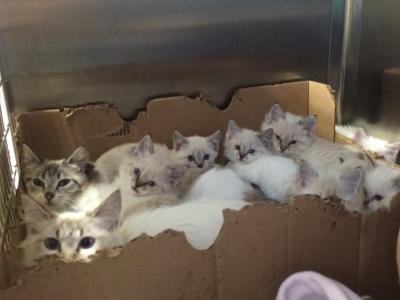
This bunch of semi-feral kittens needed lots of socialization before they were ready for adoption.
Cats and kittens are ready for adoption when they learn to trust and accept us humans. As many of the cats in our care come from the streets they’ve often had limited or negative experiences with people. By caring for them in a stable and safe home environment, our foster moms and dads are helping to charge their view of humans, which is life changing. Fostering allows these cats and kittens to grow and transform into confident kitties who will then find their forever homes.
As each cat or kitten is unique, the way foster parents socialize with them is different. For example, feral or semi-feral kitties see humans as potential predators and so they’ll run away and hide. They may hiss at you when you try to pet them or lash out by swatting or biting. In this situation the caregiver must be slow and patient. You start by sitting wherever they are – close but not too close – and make sure you have some tasty treats. As you have food, they’ll start to associate you with good things. The more they see you as non threatening, the more they’ll warm up to you. Eventually, with patience, love and persistence, an adoptable kitty emerges.
Fostering’s not only a positive experience for the kitties, but also the foster parents! It’s very rewarding to help cats and kittens get adopted. A little time and patience goes a very long way and watching them grow and learn to accept and love humans is an extraordinary feeling. Foster parents not only have immense love for kitties, but also the desire to put time and effort into giving them the best life possible. Unconditional love is given to each cat and that love changes their lives for the better.
Erin, a long time foster parent, shares a memorable story:
“My very first foster turned into my very first foster fail! I took her on while living in Australia. I had some extra time on my hands, so I asked the vet clinic close by if they had a sick or higher-needs cat that needed fostering. They were so happy since they just had a feral kitten brought in. She was extremely hissy and completely terrified of humans, so they needed her to go somewhere else aside from the vet clinic. I brought her home and got her settled into the bathroom. After hiding under the sink in the bathroom for the entire first afternoon through to the night, the next day I went in there to stay with her and do my own thing while being with her. After doing that for the morning, she came out from under the sink, crawled up on my lap, had a bath, curled up on my lap and went to sleep. I knew at that moment that I would not be giving her back at all, ever. The rest is history!
She is very much attached to me (and only me) and not great with other animals. But because of my experience with her we’ve gone on to foster 26 more kittens since then. She was my introduction into fostering and paved the way for all these other kittens to come and be a part of my life. I’m grateful for every day that we have together! And seeing how she has grown from an incredibly hissy and terrified kitten to a much more confident and happy cat, has shown me just what fostering can do for a cat. It is a life changer for them!”
Sarah, a long-term VOKRA foster parent, has fostered two “pee kitties” so far. These are kitties who pee in inappropriate places for seemingly unknown reasons. After checking with a vet to make sure there are no underlying medical issues, she goes through all the other potential reasons, such as stress and anxiety, disapproval of the little box shape or litter type, habits or any other thing she can think of. She notes all the occurrences of inappropriate peeing and the surrounding circumstances to find the patterns and modify the environment as needed. She’s just like a detective!
With one foster, all the kitty required was a larger box with deeper litter. With the other kitty, Zoey, all she needed was to have all enticing soft items, such as towels and bath mats, off the floor so the only target for pee was the litter box. All these “pee kitties” simply needed was a person with the patience to understand what they want and the willingness to create a consistent environment for them.
Sarah weighs in on why being a foster parent is an amazing opportunity:
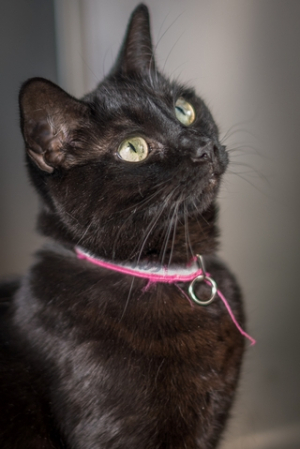
Ziggy’s one of Sarah’s former “pee kitties”. Happily she was recently adopted and now has a new forever home.
“I started fostering when I was living on my own after having moved to Vancouver by myself. I grew up with cats and adding a cat to my home seemed like a no brainer! However, as a student, I was unsure about my long-term plans so fostering allowed me to have a furry companion without committing before I was ready. It’s also so rewarding to see them improve and go off to new homes with excited new owners! And, of course, I feel like I’m helping with the larger problem of cat overpopulation and reducing strain on VOKRA as a rescue organization so that their main focus can be on those cats with greater medical needs while healthy kitties can enjoy the comfort of a home rather than a shelter environment. It also allows me to help teach others about the importance of fostering and how much fun it is!”
Fostering saves lives and we have more than 350 foster parents to thank for that! Many of our kitties need to socialize with humans and learn to accept them before being adopted and our foster homes offer the best opportunity for them get the fresh start they need. One at a time, fostering produces a transformed, adoptable kitty ready to find a loving furever home!
At VOKRA we’re always looking for new foster parents to help save more lives. We provide all the food, supplies and other equipment necessary to our foster homes, as well as ongoing support and advice. You simply provide the care, attention and love.
We have a variety of fostering situations as we take in orphaned kittens, feral kittens, pregnant mothers, mothers with kittens and adult cats. Each year we need temporary homes for more than 1,400 kittens and cats! If you’re interested in learning more about fostering, please visit our website at vokra.ca/fostering.
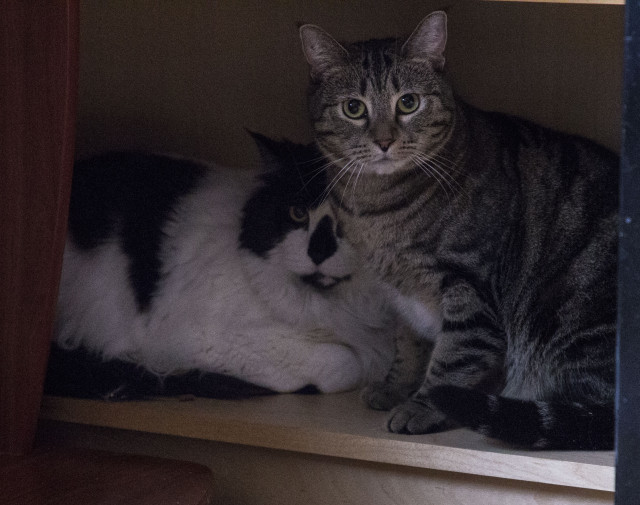
Raindrop and Steveston each grew up in difficult circumstances and came to us as semi-feral cats two years ago. They met in foster care where they became fast friends and are a great comfort to each other. They’re both still very shy, but we’re hoping an accepting and patient adopter will come along and open their heart and home to them.
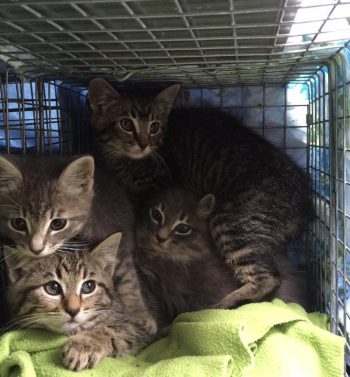 At VOKRA our mission is to end cat overpopulation and homelessness. One of the ways we’re helping accomplish this is through to Trap-Neuter-Return (TNR), the process of trapping feral cats, spaying or neutering them, and then returning them to the location they came from. We’ve seen a lot of success with TNR, but much of our time is actually spent on trapping tame strays. Trapping these cats and kittens is the first step towards finding them their furever homes.
At VOKRA our mission is to end cat overpopulation and homelessness. One of the ways we’re helping accomplish this is through to Trap-Neuter-Return (TNR), the process of trapping feral cats, spaying or neutering them, and then returning them to the location they came from. We’ve seen a lot of success with TNR, but much of our time is actually spent on trapping tame strays. Trapping these cats and kittens is the first step towards finding them their furever homes.
When we receive information about a stray cat, we find out as much information as we can to help us determine the best way to trap. We take into account how long the cat(s) has been hanging around and their lingering behaviour – are they coming at a specific time or are they around all the time? It’s important to know if they’re being fed or eating as well. Getting to know as much about the cats as possible is key to making a quick and successful trap. Behaviours such as skittishness or curiosity help us determine the correct method.
At times, it’s as easy as coaxing the cat into a carrier. Other times, setting up a trap is the only way. Traps are usually set up where the cat is being fed and include fresh tuna at the back of the trap. With feral cats, they’re taken to the vet for sedation and spay/neuter, vaccinations, ear and dental cleaning and flea treatment. They recover at our Operations Centre and are then taken back to their original location. The individual who called about the cat will be provided with food and any follow-up care. With tame cats, after they’re trapped they’re taken to our Operations Centre where we check for a microchip or tattoo. We deflea, deworm and vaccinate these kitties and have blood tests, urinalysis and teeth cleaning completed if they’re more than five years old. These tame cats are then ready for a foster home and, when they’re ready, will go up for adoption.
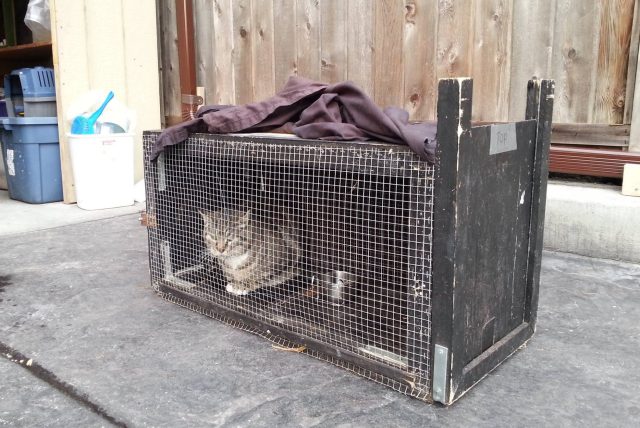
This is “Woody”, trapper Janet Cox‘s trusty wooden trap. She uses it to trap kitties who refuse to go into a metal trap. It always works like a charm!
It may seem feral cats could be more problematic than tame strays, but it’s just as important to trap these tame cats. Owned cats get lost and abandoned, which is a painful situation. If they aren’t fixed, they breed and female cats will usually give birth to their kittens outside or under garages, or amongst junk in a yard. These kittens will then grow up unsocialized by humans and grow into feral cats. If these kittens are also not spay/neutered, the cycle repeats itself and soon a feral colony will be formed. This is why it’s important for cat owners to spay and neuter their cats by five months old, and for the public to call us if they suspect a tame or feral stray who hasn’t been fixed is lingering around their neighbourhood.
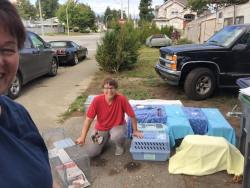
Dedicated Surrey volunteers and trappers, Anne Salomon and Mona Boucher know all the tricks to trapping.
Sometimes, our trappings don’t go as planned, as explained here by VOKRA co-founder and trapper extraordinaire Maria Soroski:
“I was called out to an industrial area in Burnaby because the business said they heard meowing coming from under the floorboards of the trailer on their property,” said Maria. “Since I couldn’t remove the floorboards, I crawled under the trailer to where they pinpointed they heard the kittens. When I found the area above me between the floorboards, I heard the noise – they were baby raccoons! I got out of there as soon as possible before the mama raccoon got mad.”
After trapping for 17 years and counting, Maria’s has countless stories. Here’s one of her most memorable ones (for cats, not racoons!):
“At least twelve years ago, I went to a location in East Vancouver where there were three adult feral cats, two female and one male, and a litter of five kittens that were eight weeks old,” explains Maria. “It was January, bitter cold that night with snow that had fallen on the ground. I set traps by the back lane garage for the kittens first and waited in my car to keep warm. Two kittens went in the traps immediately and as I was carrying the two traps to my car, I was suddenly surrounded by the adult cats. They were hissing so I ran as fast as I could to my car with the kittens in the traps while they chased me. I waited in my car again until the remaining kittens went into the traps. The three adult cats were waiting by my car, so I quickly opened the door and ran to the last traps. As I was bending down to pick up the traps, the two adult females jumped onto my back, growling and swatting. I managed to get them off me and got all the traps to my car. The adults were jumping up at my window, so I threw an open can of cat food onto the grass, started the car and drove off as they ran behind my car.”
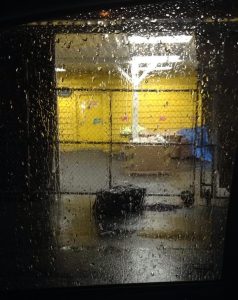
5:30 a.m. – Maria’s view as she waits patiently for some kittens, who were dumped in a back alley. to decide to go into the trap.
“I’ve never had this happen to me again, but I felt so bad for the cats as they saw their babies be driven away,” continues Maria. “The next night, I went and set traps for all three of the adult cats and took them to the vet for spaying and neutering. They stayed a couple days with us to recover and I let them see the kittens. It seemed to calm them down, knowing I didn’t cook their babies for dinner. The feral adults were returned to their original location and taken care of outside by the person who called us.”
Trapping isn’t an easy job, as we can all now see. It requires dedication and commitment to VOKRA’s mission. The trapping of tame strays is especially important as they have socialized with humans before, making them adoptable into a furever home. However, furever homes can’t exist if we don’t have pet-friendly housing. Global BC covers the issue here, making it clear our housing issues are a big cause for the loss of homes and families for too many pets. Sign the Pets OK BC petition here to help make a difference. Our trapping efforts are rendered useless if these kitties have less and less places to go once they’re ready for adoption.
Thank you to all our volunteer trappers who spend hours and hours watching over traps – be it sunshine or rain, day or night. Due to your efforts thousands of kitties have been taken off the streets and now have homes to call their own!
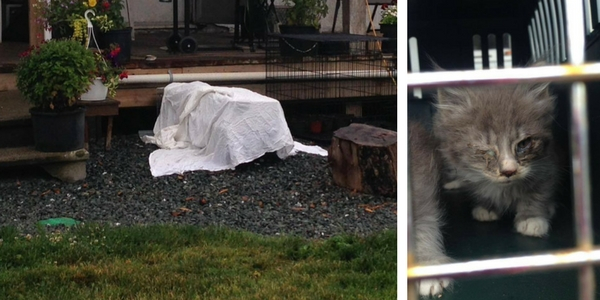
A mama and four kittens were trapped from under this porch. All the kittens had eye infections, but it was their lucky day. They were transferred to our Operations Centre for assessment and then onto foster care where they received daily treatment. Today mom and kittens are all healthy and have been adopted into loving homes.
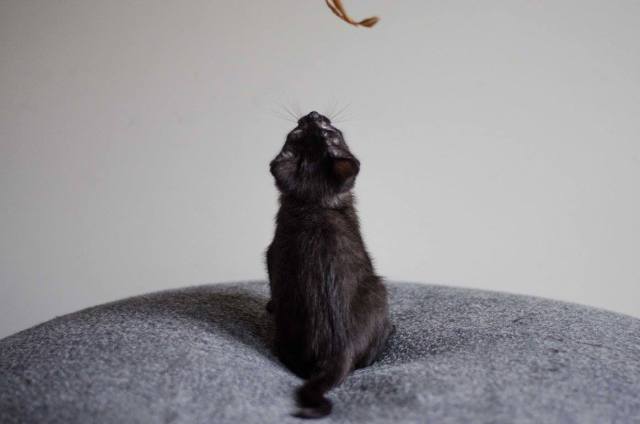
Every day the dedicated volunteers of VOKRA go to great lengths to save the lives of homeless cats and kittens from around the Lower Mainland. Little Hazel is one such kitten who may not be here today were it not for our care.
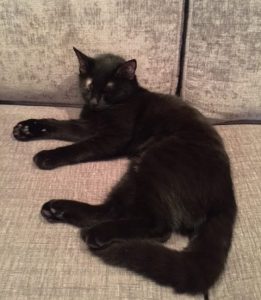 Hazel was born to a semi-feral mom who had recently been brought in to our Operations Centre. Not only was she the smallest kitten in the litter, she was born with one eye swollen shut. It turned out poor Hazel was born with an eye infection, resulting in ongoing issues with pain and poor vision in her eye.
Hazel was born to a semi-feral mom who had recently been brought in to our Operations Centre. Not only was she the smallest kitten in the litter, she was born with one eye swollen shut. It turned out poor Hazel was born with an eye infection, resulting in ongoing issues with pain and poor vision in her eye.
Hazel didn’t let her vision limitations slow her down though. She played, tumbled and chased her siblings around just like any other kitten. During one particularly active play session, Hazel’s weak eye was damaged and she was rushed to an emergency vet. It was discovered her weak eye was acting as a foreign body and had no chance of recovery, so it would eventually need to be removed.
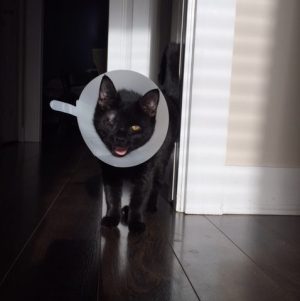 As the months passed by, all Hazel’s brothers and sisters were adopted while Hazel struggled with recurring infections, leading to her eye being removed at four months old. Unfortunately, her health problems continued and she returned for a second surgery.
As the months passed by, all Hazel’s brothers and sisters were adopted while Hazel struggled with recurring infections, leading to her eye being removed at four months old. Unfortunately, her health problems continued and she returned for a second surgery.
After two surgeries, two dewormings, four rounds of antibiotics and many more vet trips, Hazel continues to be a loving, intelligent, playful and overall adorable little ball of fluff. She’s so resilient that even two months of living with a cone around her head hasn’t slowed her down.
Happily Hazel will be available for adoption in the coming weeks. She’s a spirited little trooper who will be make some lucky family very happy. If you have room in your heart and home for little Hazel, keep an eye out for her on our ready-to-adopt page.
And if you’d like to help us pay for Hazel’s medical treatment, as well as the veterinary cost for all the other special kitties in our care, you can donate today at givetovokra.ca.
]]>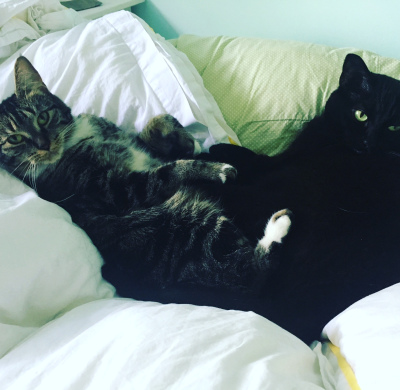 Maria Von Trapp (now Cricket) and Flossy (now Cookie) had a difficult time on their own before coming to VOKRA. Maria started life as a street cat and Flossy was removed from a household with too many cats. After an unsuccessful adoption, Maria was placed in a foster home with Flossy. The two cats bonded immediately and the decision was made to adopt out the newfound feline friends together.
Maria Von Trapp (now Cricket) and Flossy (now Cookie) had a difficult time on their own before coming to VOKRA. Maria started life as a street cat and Flossy was removed from a household with too many cats. After an unsuccessful adoption, Maria was placed in a foster home with Flossy. The two cats bonded immediately and the decision was made to adopt out the newfound feline friends together.
Having grown up with cats and wanting to adopt for quite a while, Coby was waiting for the right time to bring a cat (or two) into her home. After catsitting for a friend for several weeks, she knew she was ready to adopt and reached out to us shortly thereafter.
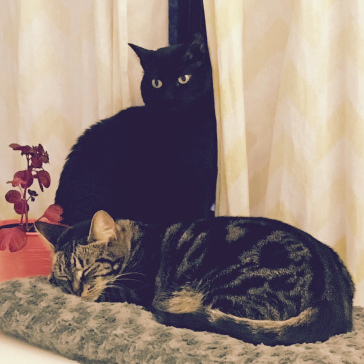 Coby immediately felt a connection to Maria and Flossy when she saw photos of them on our website. She knew she wanted to bring them home as soon she met them. Coby remembers how, “they looked so shy and nervous, which made my heart hurt. I wanted to give them a forever home where they could feel secure and loved.”
Coby immediately felt a connection to Maria and Flossy when she saw photos of them on our website. She knew she wanted to bring them home as soon she met them. Coby remembers how, “they looked so shy and nervous, which made my heart hurt. I wanted to give them a forever home where they could feel secure and loved.”
Maria and Flossy, now known as Cricket and Cookie, came home with Coby and have adjusted to their new life on their own time. Cookie loves to be the centre of attention and was happy to have couch snuggle time from the start. Cricket, however, took a while to accept she was now in a safe place and preferred to keep her distance under a table. “I’d pet her while she was under the table, which she didn’t mind, and I let her come to me on her own time,” said Coby. “For whatever reason, she has never been afraid of me when I’m in bed… she loves a long cuddle in the morning and really gets into belly and head rubs.”
Cricket has recently come around to life in a safe, happy home and has come a long way from that anxious kitty under the table. “I’m so proud of how far little Cricket has come,” said Coby. “In just the past couple of weeks she has started to snuggle in with Cookie and me on the couch. I’m pretty proud of Cookie too, as she used to swat her away, so Cricket’s first attempts to cuddle were thwarted by her sister from another mister.”
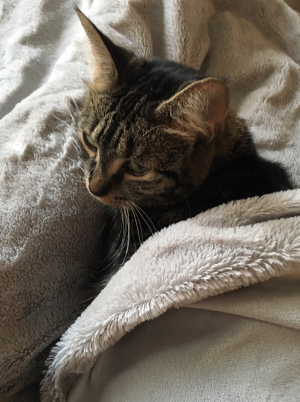 Cats are, by nature, creatures of habit and Cricket and Cookie are no exception. They have set the schedule for playtime, bedtime and TV time! Cricket likes to hang out in her ‘kitty cave’ with one eye on the TV and the other on Coby and Cookie. While Cookie likes to remind Cricket of who’s the alpha kitty in the household, they live a peaceful co-existence and have learned to share the attention and toys.
Cats are, by nature, creatures of habit and Cricket and Cookie are no exception. They have set the schedule for playtime, bedtime and TV time! Cricket likes to hang out in her ‘kitty cave’ with one eye on the TV and the other on Coby and Cookie. While Cookie likes to remind Cricket of who’s the alpha kitty in the household, they live a peaceful co-existence and have learned to share the attention and toys.
Cricket and Cookie definately hit the jackpot with their new person Coby! Thank you for giving these girls a loving, happy home. We wish them many happy years of couch cuddles and TV time to come.
Would you like to share your Happy Tail? Email us at [email protected].
]]>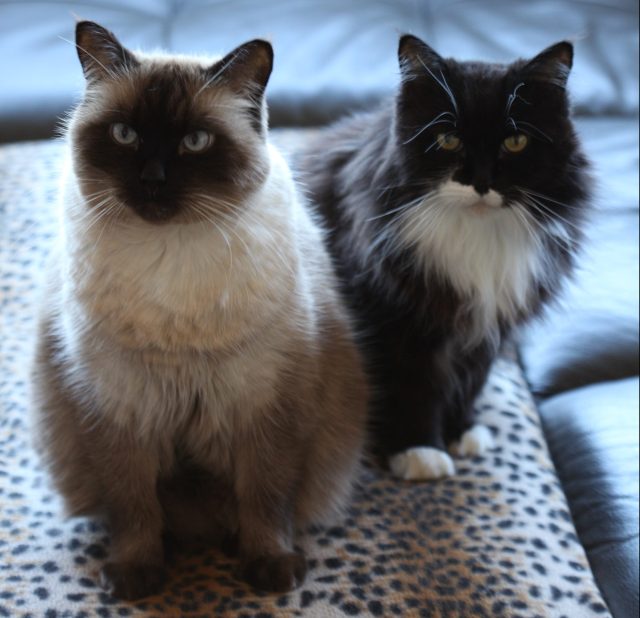
In typical Vancouver fashion, Mike still lives with his mom Trixie. He loves attention and, when inspired, he wanders over to purr loudly and lean into your hand. He’s always the first to greet you by asking for pets, pumping his head against your hand and weaving around your legs. He’s also very enthusiastic about play and will swat at toy mice and chase sticks and strings moving across the floor. As his confidence grows, he’s even starting to show enthusiasm for rolling balls with bells. A handsome gentleman, Mike likes to saunter around the house with ears relaxed and tail held high. He likes to find cozy perches where he can watch the world go by.
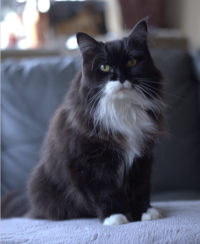 Trixie will sit her little self on your hip or your chest when you lie down, purring contentedly whenever you’re awake enough to rub her ears. She loves a good place to perch or to hide and peek out of when she feels like keeping to herself. Other times she likes to saunter into a room and observe its goings on. An avid foodie, she likes to sit just outside the kitchen to watch and sniff while you cook. She will, of course, offer to test your creations. She also likes little chats and will respond if you meow back at her – be ready for a full conversation! Trixie may put on a bit of a grumpy face at times, but she’s especially quick to purr. Purring begets cuddling, which will result in louder purring and louder purring will result in drooling. It’s adorable!
Trixie will sit her little self on your hip or your chest when you lie down, purring contentedly whenever you’re awake enough to rub her ears. She loves a good place to perch or to hide and peek out of when she feels like keeping to herself. Other times she likes to saunter into a room and observe its goings on. An avid foodie, she likes to sit just outside the kitchen to watch and sniff while you cook. She will, of course, offer to test your creations. She also likes little chats and will respond if you meow back at her – be ready for a full conversation! Trixie may put on a bit of a grumpy face at times, but she’s especially quick to purr. Purring begets cuddling, which will result in louder purring and louder purring will result in drooling. It’s adorable!
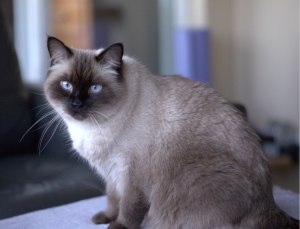 There’s something quite spectacular about coming home to a pair of sweet cats who just can’t wait for you to come and snuggle up with them! Trixie and her son Mike have slowly been coming out of their shells and showing the depths of their affection and fondness for play. While still inclined to avoid noise, they bloom in quiet places, coming out to seek pets and to check up on you. They aren’t shy about sauntering into the living room and reminding you when it’s time for dinner and time for bed. Evening is their favorite time, as they adore snuggling up in bed with you.
There’s something quite spectacular about coming home to a pair of sweet cats who just can’t wait for you to come and snuggle up with them! Trixie and her son Mike have slowly been coming out of their shells and showing the depths of their affection and fondness for play. While still inclined to avoid noise, they bloom in quiet places, coming out to seek pets and to check up on you. They aren’t shy about sauntering into the living room and reminding you when it’s time for dinner and time for bed. Evening is their favorite time, as they adore snuggling up in bed with you.
Trixie and Mike are looking for a forever home together with no kids, dogs or other cats. If you’re interested in giving them a home you can apply to adopt here.
]]>